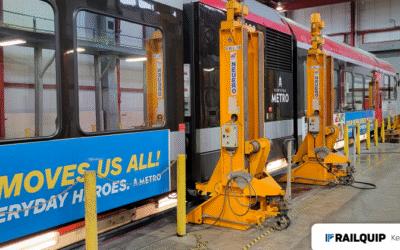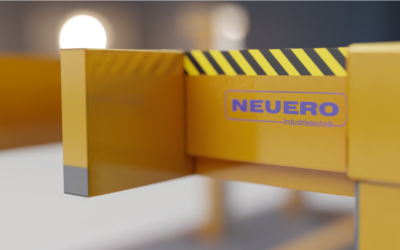Essential Railway Lifting Equipment: Find the right fit for your needs
Selecting the right railway lifting equipment is essential for efficient and safe rail maintenance operations.
Whether you need to lift railcars for routine maintenance or urgent repairs, having the right equipment ensures smooth workflows and minimal downtime. But with various options available, how do you choose the best fit for your needs?
This guide will help you explore Railquip’s diverse range of lifting equipment, from portable jacks and drop tables to underfloor lifting systems, body supports, and coupler lifts, ensuring you find the most suitable solution for your railway maintenance needs.

Why is choosing the right lifting equipment important for rail maintenance operations?
Railway maintenance involves handling massive railcars, bogies, and couplers that require stable, reliable, and precise lifting.
Without the appropriate equipment, maintenance operations can become inefficient, costly, and even dangerous. The right lifting solutions help teams work faster and safer while ensuring that every maintenance procedure is performed correctly.
- Faster maintenance turnarounds: Reducing downtime and keeping trains in service.
- Operator safety: Preventing accidents with stable and reliable lifting solutions.
- Adaptability to various railcar types: Ensuring compatibility across different maintenance tasks.
A great example of efficient lifting solutions in action is the O-Train project. In 2015, the O-Train in Ottawa, Canada, required a complete train maintenance facility for its new fleet.
Railquip provided a fully customized stationary underfloor lifting system designed to fit the exact space and operational needs of the O-Train maintenance facility. By integrating these advanced lifting solutions, the O-Train maintenance team was able to reduce downtime and enhance overall efficiency.
What lifting heights are achievable with each type and what are their key features and benefits?
Railquip different lifting solutions offer varying height capabilities depending on their design and purpose. Whether working on small adjustments or full-scale repairs, selecting the right equipment ensures accessibility and operational efficiency.
Also, each type of railway lifting equipment is designed with unique features to accommodate various maintenance needs. The right choice depends on factors such as ease of movement, weight capacity, and operational efficiency:
- Portable Jacks: Designed for lifting railcars and locomotives efficiently, these jacks support up to 60 tons per unit and provide lifting heights of over 100 inches. Mobile, easy to transport, and can lift heavy loads with minimal setup
- Underfloor Car Hoists & Body Supports: These systems provide a stable platform for bogie maintenance and are designed to allow full undercarriage access. They provide secure lifting for bogies keeping railcars in place.
- Drop Tables: Used for removing and reinstalling traction motors, wheelsets, and bogies, offering a greater range of motion. Stationary but offer greater lifting precision and full access to essential components. Railquip’s work with WMATA showcases how a custom-designed drop table solution can enhance efficiency, reduce costs, and improve safety while seamlessly fitting into existing infrastructure.
- Coupler Lift Systems: Designed to lift railcar couplers with capacities of up to 50 tons, these systems facilitate safe and efficient replacement procedures. They are designed for handling heavy-duty couplers, reducing manual labour and increasing efficiency.
- Heavy-Duty Mobile Support Stands: With capacities of up to 20 tons, these adjustable-height stands provide stable support for railcars during maintenance operations. Adjustable and easy to move, offering additional support for stationary maintenance.

What are the primary applications of portable jacks and drop tables in rail maintenance?
Portable jacks and drop tables are essential for rail maintenance, but they serve different roles. Understanding their applications helps maintenance teams choose the best solution for each situation.
- Portable jacks are ideal for quick repairs, inspections, and emergency lifting due to their mobility and ease of setup.
- Drop tables are designed for removing wheelsets, bogies, and traction motors, offering a fixed and more controlled lifting solution. Offer a larger range of motion, allowing the removal and replacement of heavy components while keeping the changeout process underground, allowing for more space on the shop floor and freeing up the need to use the overhead crane.
Which type of equipment is easier to set up and operate, both in routine maintenance and emergency situations?
Ease of setup and operation play a major role in maintenance efficiency. The right equipment should be simple to deploy and use, reducing downtime while ensuring worker safety.
Underfloor Hoists and Coupler Lifts require dedicated space and permanent setup, offering high-efficiency lifting in structured maintenance bays, but can end up causing expensive changes in the future with possible new vehicle purchases that have different lifting locations.
Portable jacks are easier to set up and can be operated at the main control panel or locally with a pendant controller on each jack.
Drop tables require a fixed installation with a much bigger investment, but are safer by removing the need to lift heavy rail vehicles to great heights .
Considering all factors, which type of equipment is the best fit for different rail maintenance scenarios?
Choosing the right lifting equipment depends on various operational factors, including the type of maintenance being performed, the available infrastructure, and efficiency needs. Evaluating these criteria ensures the best selection for the task at hand.
- For emergency or quick repairs: Portable Jacks
- For bogie and traction motor replacements: Drop Tables
- For long-term, structured maintenance: Underfloor Hoists & Body Supports
- For coupler handling and replacements: Coupler Lifts
- For additional support in fixed locations: Mobile Support Stands
Conclusions
Railquip offers a comprehensive range of railway lifting equipment designed to meet the demands of modern rail maintenance. Whether you need portable jacks for quick repairs, drop tables for extensive overhauls, or underfloor lifting systems for efficient bogie maintenance, there is a solution tailored to your needs.
By evaluating factors such as load capacity, safety features, and operational flexibility, railway operators can select the most effective lifting equipment to enhance maintenance efficiency and ensure long-term reliability.
Looking for the ideal railway lifting solution?
Contact Railquip today to explore our versatile, high-performance, and safety-certified lifting equipment tailored to your railway maintenance operations.



